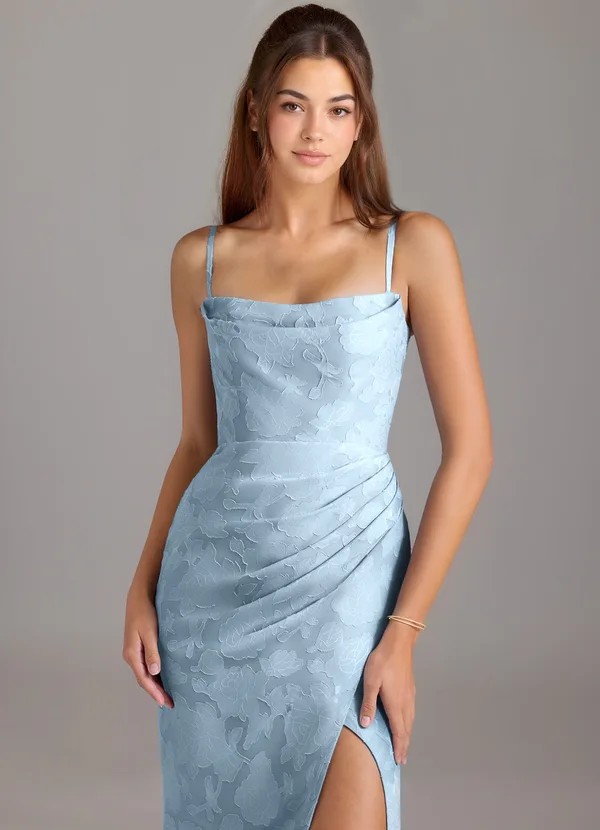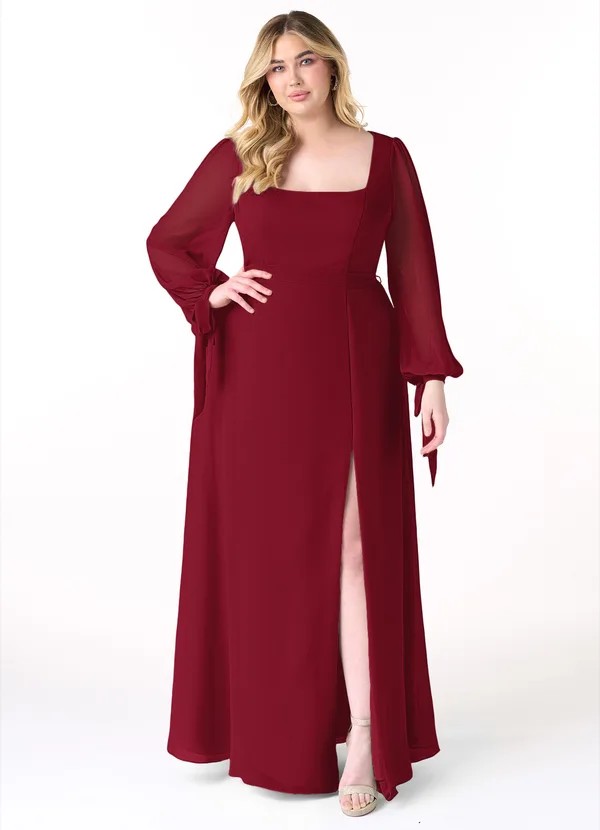What Is the Difference Between a Strapless and a Long-Sleeve Bridesmaid Dress?

Strapless bridesmaid dresses have no straps or sleeves and expose the shoulders and arms. They work best for spring and summer weddings in warm venues.
Long-sleeve bridesmaid dresses cover the arms completely and provide more coverage. They suit fall and winter weddings, formal events, and bridesmaids who prefer modest styling.
Strapless dresses require 2–3 fittings for proper bodice support. Long-sleeve styles need 1–2 fittings mainly for sleeve and hem length.
Key Differences at a Glance
| Feature | Strapless | Long-Sleeve |
| Coverage | Minimal—shoulders and arms exposed | Full—arms completely covered |
| Best season | Spring, Summer | Fall, Winter |
| Support needed | Built-in boning, grip tape, strapless bra | Standard bra, no special undergarments |
| Fittings required | 2–3 (bodice fit critical) | 1–2 (sleeve length, hem) |
| Movement freedom | High—no sleeve restriction | Medium—depends on fabric stretch |
| Formal level | Cocktail to formal | Semi-formal to black-tie |
| Body confidence | Must feel secure without straps | Provides arm coverage and comfort |
Steps to Choose Between Strapless and Long-Sleeve

Step 1: Consider Your Wedding Season
Match sleeve style to your wedding date and climate. Strapless works for May through September outdoor weddings.
Long-sleeve suits October through April ceremonies. Indoor climate-controlled venues offer flexibility for either style.
Step 2: Assess Venue Temperature
Check if your venue has air conditioning or heating. Outdoor summer receptions favor strapless for comfort.
Winter ballrooms can be drafty—long sleeves provide warmth. Beach and garden venues work best with strapless styles.
Step 3: Evaluate Bridesmaid Comfort Levels
Ask each bridesmaid about coverage preferences. Some feel more confident with arm coverage.
Others prefer the freedom of strapless. Consider offering both options in the same color and fabric for mixed preferences.
Step 4: Match Your Wedding Formality
Black-tie and formal evening weddings pair well with long-sleeve elegance. Strapless suits cocktail and semi-formal events.
Garden and beach weddings lean toward strapless. Classic church ceremonies can accommodate either style.
Step 5: Factor in Body Type Preferences
Strapless flatters athletic and hourglass figures with defined shoulders. Long-sleeve styles suit bridesmaids who prefer arm coverage or have fuller upper arms.
Both styles work for all body types with proper fitting. Personal comfort matters more than body shape rules.
Strapless Bridesmaid Dress Details

Design Features:
- Bodice ends at or just above bust line
- No straps, sleeves, or shoulder coverage
- Usually includes boning or structure for support
- Straight, sweetheart, or curved neckline options
- Requires grippy interior lining or tape
Best Body Types:
- Athletic builds with defined shoulders
- Hourglass figures
- Those comfortable showing upper body
- Bridesmaids with good posture
- Anyone who wants maximum movement freedom
Support Requirements:
- Strapless bra with strong band
- Built-in cups or padding
- Silicone grip tape along top edge
- Proper bodice boning
- Tight fit through ribcage area
Seasonal Advantages:
- Keeps bridesmaids cool in summer heat
- Shows off tanned shoulders
- Pairs well with statement necklaces
- Allows freedom for dancing
- Photographs beautifully in natural light
Long-Sleeve Bridesmaid Dress Details

Design Features:
- Sleeves extend to wrists
- Full arm coverage from shoulder to hand
- Can be fitted, flowy, or bell-shaped
- Various neckline options available
- May include button or zipper closures at wrists
Best Body Types:
- All body types—universally flattering
- Those who prefer upper arm coverage
- Bridesmaids wanting elegant, modest look
- Anyone seeking extra warmth
- All comfort levels with sleeveless styles
Support Requirements:
- Standard bra (any style works)
- No special grip tape needed
- Regular fitting at shoulders and bust
- Sleeve length adjustment important
- Easier alterations than strapless
Seasonal Advantages:
- Provides warmth for fall and winter
- Protects arms from air conditioning
- Creates sophisticated, formal appearance
- No constant adjusting needed
- Works in religious venues requiring modesty
Comfort and Fit Comparison
| Comfort Factor | Strapless | Long-Sleeve |
| Security feeling | Requires confidence without straps | Secure—nothing to slip or fall |
| Temperature | Cooler—more skin exposed | Warmer—full coverage |
| Movement | Complete arm freedom | Some restriction in fitted sleeves |
| Adjustment needs | Frequent pulling up during event | Minimal—stays in place |
| Undergarment ease | Special strapless bra required | Any bra style works |
| Sitting comfort | May compress at ribcage | Sleeves may wrinkle when seated |
| Dancing ease | Maximum freedom | Good—depends on sleeve fit |
Styling Differences

Strapless Styling Options:
- Statement necklaces and chokers
- Drop earrings for shoulder emphasis
- Updo hairstyles to show neckline
- Delicate shawls or wraps for ceremony
- Bare shoulders highlight jewelry
Long-Sleeve Styling Options:
- Focus on bracelets and rings
- Earrings remain important
- Hair worn down or in loose waves
- Minimal neckline jewelry needed
- Elegant, covered look without accessories
Alteration Requirements
| Alteration Type | Strapless Needs | Long-Sleeve Needs |
| Bodice fit | Critical—must be snug | Important but standard |
| Bust adjustments | Often needed for support | Standard cup alterations |
| Sleeve length | N/A | Usually needs adjustment |
| Hem length | Standard across both | Standard across both |
| Shoulder fit | N/A | Important for comfort |
| Total fittings | 2–3 recommended | 1–2 typically sufficient |
| Alteration time | 2–3 weeks | 1–2 weeks |
Seasonal Suitability Guide
Spring Weddings (March–May):
- Strapless: Excellent for outdoor venues
- Long-Sleeve: Good for evening or indoor ceremonies
- Best choice: Strapless for garden, long-sleeve for church
Summer Weddings (June–August):
- Strapless: Ideal for heat management
- Long-Sleeve: Only in lightweight, breathable fabrics
- Best choice: Strapless for beach and outdoor
Fall Weddings (September–November):
- Strapless: Works with wraps or jackets
- Long-Sleeve: Perfect for cooler temperatures
- Best choice: Long-sleeve for elegance and warmth
Winter Weddings (December–February):
- Strapless: Requires substantial cover-ups
- Long-Sleeve: Provides necessary coverage
- Best choice: Long-sleeve for comfort and style
Venue-Specific Recommendations
| Venue Type | Strapless Rating | Long-Sleeve Rating | Why |
| Beach | Excellent | Poor | Heat and casual vibe favor strapless |
| Garden | Excellent | Good | Outdoor warmth suits strapless best |
| Ballroom | Good | Excellent | Formal setting enhances long-sleeve elegance |
| Church | Good | Excellent | Modesty preferences often favor coverage |
| Barn/Rustic | Good | Good | Either works—depends on season |
| Rooftop | Excellent | Fair | Open air and views suit strapless |
| Museum/Gallery | Fair | Excellent | Formal, sophisticated venues favor sleeves |
Movement and Activity Considerations
Dancing Freedom:
- Strapless: Complete arm mobility, no fabric restriction
- Long-Sleeve: Some limitation with tight sleeves, better with flowy styles
Photo Posing:
- Strapless: Clean lines, emphasizes posture and shoulders
- Long-Sleeve: Elegant draping, sophisticated hand placement options
Ceremony Standing:
- Strapless: May need adjustment after sitting then standing
- Long-Sleeve: Stays in place without adjustment
Reception Activities:
- Strapless: Cooler for active dancing and mingling
- Long-Sleeve: Better for air-conditioned venues
Frequently Asked Questions
Can bridesmaids mix strapless and long-sleeve styles?
Yes, but keep other elements consistent for cohesion. Use the same color, fabric, and length for both styles.
This creates visual unity while accommodating different comfort levels. Test the look with photos before finalizing.
How many fittings does a strapless dress need?
Strapless dresses typically need 2–3 fittings. The first fitting checks overall fit and bodice security.
The second adjusts any issues, and a third ensures everything stays in place. Proper bodice fit prevents slipping during the event.
Do long-sleeve bridesmaid dresses work in summer?
Yes, if you choose lightweight, breathable fabrics like chiffon or mesh. Avoid heavy satin and velvet in warm weather.
Select lighter colors that reflect heat. Indoor air-conditioned venues make long sleeves more comfortable in summer.
Which style is more flattering for plus-size bridesmaids?
Both can flatter plus-size figures with proper fit. Long sleeves offer arm coverage that many prefer.
Strapless works well with A-line or empire waist silhouettes. Personal comfort and confidence matter most—let each bridesmaid choose.
Can I add sleeves to a strapless dress later?
Adding permanent sleeves is difficult and expensive. Instead, use detachable sleeve options or elegant wraps.
Many designers offer matching boleros or jackets. This provides flexibility for ceremony coverage and reception comfort.
What undergarments work best with each style?
Strapless dresses require strapless bras with wide bands and silicone grip. Long-sleeve dresses work with any bra style.
For strapless, use body tape or built-in cups for extra security. Long-sleeve options offer more undergarment flexibility.
Fabric Choices by Style
Best Fabrics for Strapless:
- Satin—holds structure and shape
- Structured chiffon with lining
- Taffeta—provides body and support
- Crepe—smooth and form-fitting
- Any fabric with built-in boning
Best Fabrics for Long-Sleeve:
- Lightweight chiffon—breathable and flowing
- Stretch mesh—comfortable movement
- Lace—elegant and timeless
- Velvet—luxurious for winter
- Jersey knit—comfortable stretch
Cost Considerations (Time and Alterations)
| Factor | Strapless | Long-Sleeve |
| Fabric amount | Less material used | More fabric required |
| Alteration complexity | Higher—bodice critical | Lower—standard adjustments |
| Fitting time needed | 3–4 hours total | 2–3 hours total |
| Rush alteration difficulty | Harder to perfect quickly | Easier for quick adjustments |
| Accessories needed | Strapless bra, tape, wraps | Standard undergarments |
Decision-Making Checklist
Choose Strapless If:
- Wedding is May through September
- Venue is outdoor or warm
- Bridesmaids prefer minimal coverage
- You want a lighter, airier look
- Dancing and movement are priorities
- Style is cocktail or semi-formal
Choose Long-Sleeve If:
- Wedding is October through April
- Venue requires modesty or formality
- Bridesmaids want arm coverage
- You prefer sophisticated elegance
- Climate control is uncertain
- Style is formal or black-tie
Mix-and-Match Strategy
You can successfully mix both styles by keeping these elements identical:
- Color: Exact same shade and dye lot
- Fabric: Same material and texture
- Length: All floor-length or all knee-length
- Silhouette: Same skirt shape (A-line, sheath, etc.)
This creates cohesion while offering personal choice. Photograph test shots to ensure visual harmony.
Key Takeaways
Strapless bridesmaid dresses expose shoulders and work best for spring and summer weddings. They require strapless bras, grip tape, and 2–3 fittings for secure bodice fit.
Long-sleeve bridesmaid dresses provide full arm coverage and suit fall and winter events. They need 1–2 fittings and work with any undergarments.
Both styles flatter all body types when properly fitted. Choose based on season, venue, formality level, and bridesmaid comfort preferences.